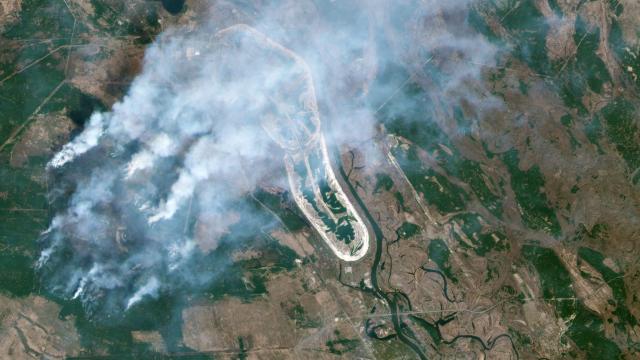Chernobyl is still on fire. Satellite images captured Thursday by Planet Labs show wildfires inching closer to the Chernobyl Nuclear Power Plant in Ukraine.
The fires first started Saturday inside the 2,589-square kilometre exclusion zone centered around the plant, which suffered a massive explosion in 1986. Radiation levels spiked to 16 times higher than normal at the centre of the fires, raising concerns for the health and safety of the fire crews tasked with battling the flames.
The satellite images show the fires are burning within roughly five miles of the now-shuttered nuclear plant and the neighbouring ghost city of Pripyat. It’s unclear if these are the same fires that started this weekend. The Ukrainian had said to NBC News Monday that the human-caused fires were out, yet the satellite images clearly show flames continuing to burn on Thursday. The fires appear to have been caused by someone who lit grass ablaze, which then spread to nearby trees. The region is also vulnerable to naturally caused wildfires, a risk that will increase as the planet heats up.
In 2010, the region saw some 54 fires in contaminated areas and 300 elsewhere, according to a paper published in Environmental International in 2014. The paper goes on to outline the way climate change is increasing temperatures and worsening the conditions for drought in the region, creating ideal conditions for wildfires. Lack of human intervention has also left enough organic fuel such as dead trees and leaves to further fuel large wildfires.
Wildfires are concerning anywhere, but even more so when what’s burning is radioactive. We’ve seen circumnavigate the globe.
The current Chernobyl blazes are nowhere near the scope of those fires, and radiation transport concerns are fairly low. The Ukrainian government has said that the capital city of Kiev and its surrounding suburbs about 60 miles to the south are not affected by the fires, and radiation levels remain normal there.
But if Chernobyl suffers larger fires in the future that cover anywhere from 10 per cent to 100 per cent of the area, the 2014 study found that “significant amounts” of radiation could migrate to communities in Central and Eastern Europe. Wild animals may be returning to Chernobyl, and the site may be open to tourists, but radiation is still hiding under the surface. And a little more heat could let it out.
